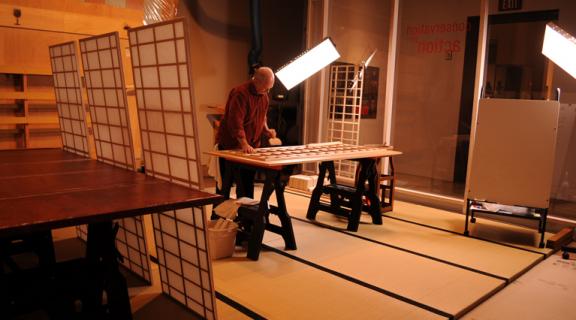In the fall of 2012, conservators prepared a set of wooden undercores for two Japanese folding screens in need of new supports. Supports for East Asian paintings are necessary because they are often made on fine and easily damaged materials, such as paper or silk. Over the course of several weeks, the work to construct proper mounts was conducted on view to the public.
Wooden Undercores
Various mounting formats, refined over centuries in China, Japan, and Korea, are used to protect and display Asian paintings safely. Rolled or flexible formats include hanging scrolls and hand scrolls, while other works are mounted in rigid panel formats as screens, doors, and framed paintings. The proper support is essential for the well-being of the artwork. Over time, poor mounting can have a detrimental effect on the object, as can be seen below in this six-panel folding screen from the 19th century.

This screen came into the Museum’s collection in 1911 in an inadequately mounted state, perhaps hastily and inexpensively constructed. The poor quality wooden core, with too few layers of lining paper, began to distort and caused a darkening discoloration that spread to the painting. The painting has now been removed from the screen core to halt this damage, while it awaits the preparation of a new, strong, and stable screen core.
Conservation Strategy

For this project, wooden lattice undercores like the ones pictured above will be made from Japanese cedar. Eight layers of handmade Japanese paper will then be applied to the front and back of each panel. The panels will be hinged together with strong Japanese handmade papers so that the screens can be folded in both directions.

For the 16th century Japanese folding screen above, the wooden lattice core has several layers of paper pasted on both sides, providing a lightweight but strong and smooth surface that can support the artwork. Most Japanese screen mountings also include a decorative border of paper or fabric and a protective outer wooden trim.
Conservation in Action
As work progresses, updates will be posted below.
